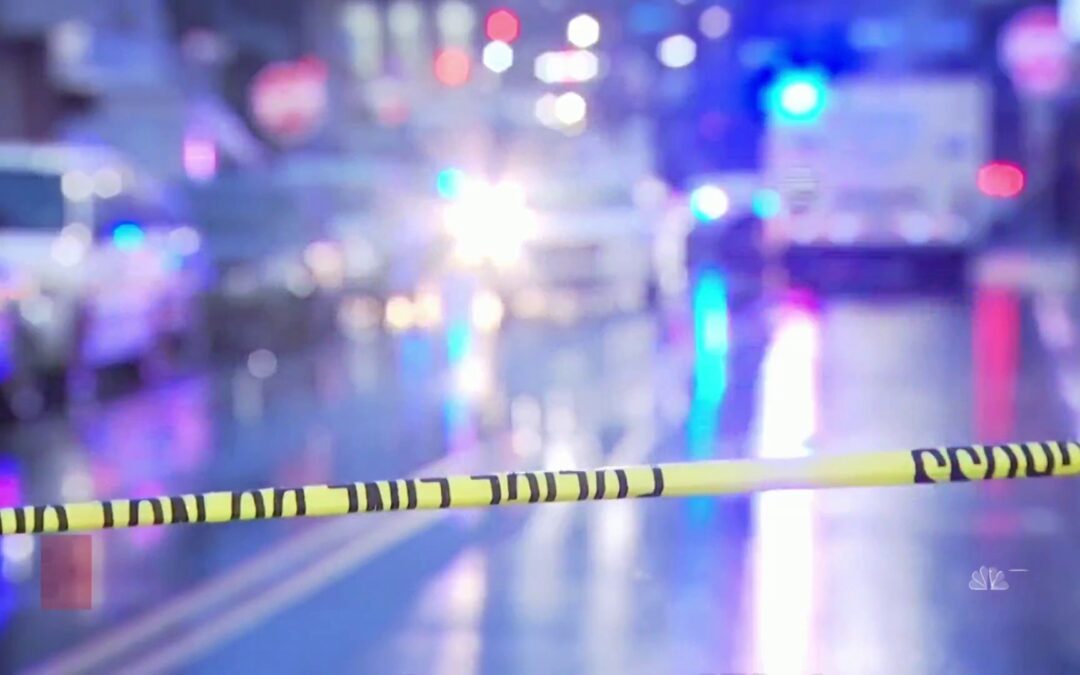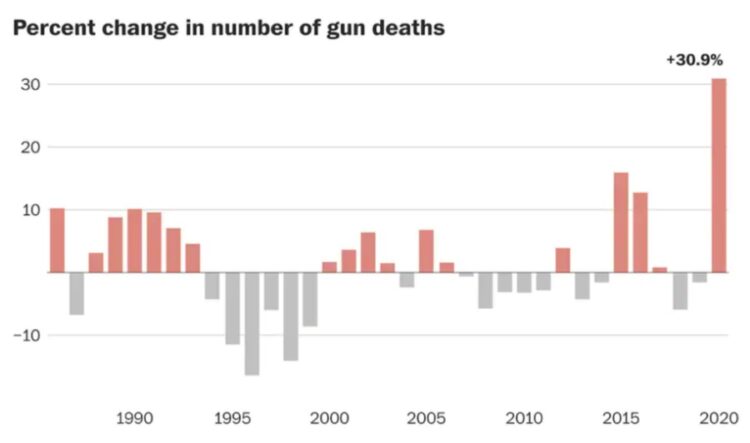Killings in the United States jumped nearly 30 percent last year, the final year of the Trump presidency, according to FBI data released today that indicates a growing number of gun-related slayings during the pandemic.
The FBI said murder and manslaughter rose 29.4 percent — the largest one-year increase since the federal government began compiling national figures in the 1960s.
That historic increase has been known for some time and has sparked concern from police officials and prosecutors.
But the FBI’s release of data compiled from thousands of law enforcement agencies formally confirms the trend.
Overall, violent crime rose 5.6 percent in 2020, while property crimes fell 7.8 percent, the FBI said.
Assaults increased 12 percent, according to the bureau.
Criminologists and police officials have been studying possible explanations for the sudden, sharp increase in killings — from societal changes because of the coronavirus, to changes in policing, to increased gun sales.
So far this year, officials are seeing a further increase in homicides but not as pronounced as last year.
The FBI data also shows how much killing in America is fueled by shootings. Guns accounted for 73 percent of homicides in 2019, but that increased to 76 percent of homicides in 2020.
Gun killings rose 55 percent in Houston, from 221 in 2019 to 343 in 2020. Overall, the city saw more than 400 killings last year.
Overall, however, crime is still well below the historic highs reached in the early 1990s.
And in many cities, including Washington, D.C., New York and Chicago, the number of killings is still far below the record-high tolls from nearly 30 years ago.
“Homicides jumped almost everywhere, while overall crime was down, so there’s no real surprises in this,” said Justin Nix, an associate professor of criminology and criminal justice at the University of Nebraska in Omaha.
Nix said the most likely culprits for the sharp spike in killings are twofold: the pandemic and what he called a “police legitimacy crisis” brought on by the videotaped killing last year of George Floyd by a police officer in Minneapolis.
That incident and others have caused many people to trust police less, making them less willing to call for help or provide information to investigators about killings, Nix said.
He added that the effect is magnified when officers “de-police” by pulling back from patrol and other duties in the face of public criticism.
On top of that, Nix said, the data suggests there may be more people carrying and using guns in public spaces, leading to more killings.
Republican and Democratic elected officials disagree on what is causing the increase in homicides after years of decline, and how to stop it.
Conservatives blame Democratic-run cities for what they say are overly restrictive policies placed on police departments; the Biden administration faults the easy availability of guns as a primary reason for more deaths, and the Justice Department is trying to stem the violence by cracking down on illegal gun trafficking.
The disturbing crime data comes as the FBI is pushing the nation’s roughly 18,000 state and local law enforcement agencies to change how they provide information to calculate national figures and trends.
The switch to the new crime data format, known as the National Incident-Based Reporting System (NIBRS) has been a years-long process.
But officials say 2020 is the last year for which data reported through the old system will be accepted.
Many law enforcement agencies don’t yet provide the FBI with the data that is needed for the new system, leaving some crime experts to predict that national crime figures will get more shaky in the short term, with markedly fewer jurisdictions included in the FBI summary that comes out each fall.
“It’s a little bit like cleaning out your garage — first you put a lot of stuff on the lawn, so it looks worse before it looks better,” said Mitch Beemer, who manages crime data for the Kansas Bureau of Investigation, which adopted a similar data-tracking program years earlier. “But I’m optimistic that we are moving in the right direction and will get most of the way there in five or six years.”
Nix, the criminologist, said when it comes to the FBI’s data, “I’m kind of worried about the future because I think we’re about to have a real blind spot for the next few years.”
Changes in crime rates have long fueled political debates over gun laws, and the newly released data is likely to intensify that trend.
On Monday, gun control advocates said a large increase in first-time gun owners around the start of the pandemic probably played a significant role in rise in shooting deaths.
“We know having a gun in your home, having a gun in public, makes you less safe and more likely to be a victim and perpetrator of gun violence,” said Ari Davis, a policy analyst at the Coalition to Stop Gun Violence.
Davis said he was concerned about states that are repealing local gun control measures and passing “stand your ground” laws, which allow people to use deadly force in public — without a duty to retreat — if they are being attacked or threatened.
With more guns circulating in communities, Davis said, “that’s a dangerous mix. When we’re talking about community-based gun violence, that kind of violence can be retaliatory.
If we don’t interrupt now, the spikes of today in gun violence can be hard to reduce even when the causes, like covid, are gone.”
But Daniel Webster, director of the Johns Hopkins University’s Center for Gun Violence Prevention and Policy, said it was too early to tie the jump in gun sales to new owners to the rise in shooting deaths.
He noted police departments in 2020 had personnel shortages because of the pandemic and adopted new rules at some agencies designed to curb abusive policing.
“Having an environment in which there are slightly fewer cops, with more out for covid and more of them not doing proactive things, that creates a place in which people might want to carry guns around, might be prone to do bad things with those guns,” Webster said.
This article appeared in The Washington Post.

